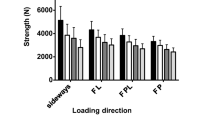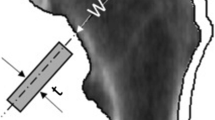Abstract
Introduction
Proximal femoral bone strength is not only a function of femoral bone mineral density (BMD), but also a function of the spatial distribution of bone mass intrinsic in structural geometric properties such as diameter, area, length, and angle of the femoral neck. Recent advancements in bone density measurement include software that can automatically calculate a variety of femoral structural variables that may be related to hip fracture risk. The purpose of this study was to compare femoral bone density, structure, and strength assessments obtained from dual-energy X-ray absorbtiometry (DXA) measurements in a group of women with and without hip fracture.
Methods
DXA measurements of the proximal femur were obtained from 2,506 women 50 years of age or older, 365 with prior hip fracture and 2,141 controls. In addition to the conventional densitometry measurements, structural variables were determined using the Hip Strength Analysis program, including hip axis length (HAL), cross-sectional moment of inertia (CSMI), and the femur strength index (FSI) calculated as the ratio of estimated compressive yield strength of the femoral neck to the expected compressive stress of a fall on the greater trochanter.
Results
Femoral neck BMD was significantly lower and HAL significantly higher in the fracture group compared with controls. Mean CSMI was not significantly different between fracture patients and controls after adjustment for BMD and HAL. FSI, after adjustment for T score and HAL, was significantly lower in the fracture group, consistent with a reduced capacity to withstand a fall without fracturing a hip.
Conclusion
We conclude that BMD, HAL, and FSI are significant independent predictors of hip fracture.







Similar content being viewed by others
References
Lin JT, Lane JM (2004) Osteoporosis: a review. Clin Ortop 425:126–134
Nurmi I, Narinen A, Luthje P, Tanninen S (2003) Cost analysis of hip fracture treatment among the elderly for the public health services: a 1-year prospective study in 106 consecutive patients. Arch Orthop Trauma Surg 123:551–554
Woolf AD, Pfleger B (2003) Burden of major musculoskeletal conditions. Bull World Health Organ 81:646–656
Melton LJ III, Gabriel SE, Crowson CS, Tosteson AN, Johnell O, Kanis JA (2003) Cost–equivalence of different osteoporotic fractures. Osteoporos Int 14:383–388
Khasraghi FA, Lee EJ, Christmas C, Wenz JF (2003) The economic impact of medical complications in geriatric patients with hip fracture. Orthopedics 26:49–53
Melton LJ III (2003) Adverse outcomes of osteoporotic fractures in the general population. J Bone Miner Res 18:1139–1141
Johnell O, Kanis JA, Oden A, Sernbo I, Redlund–Johnell I, Petterson C, De Laet C, Jonsson B (2004) Mortality after osteoporotic fractures. Osteoporos Int 15:38–42
Johnell O, Kanis JA (2004) An estimate of the worldwide prevalence, mortality and disability associated with hip fracture. Osteoporos Int 15:897–902
Empana JP, Dargent Molina P, Breart G, EPIDOS Group (2004) Effect of hip fracture on mortality in elderly women: the EPIDOS prospective study. J Am Geriatr Soc 52:685–690
Olszynski WO, Shawn Davison K, Adachi JD, Brown JP, Cummings SR, Hanley DA, Harris SP, Hodsman AB, Kendler D, McClung MR, Miller PD, Yuen CK (2004) Osteoporosis in men: epidemiology, diagnosis, prevention, and treatment. Clin Ther 26:15–28
Youm T, Koval KJ, Zuckerman JD (1999) The economic impact of geriatric hip fractures. Am J Orthop 28:423–428
Woolf AD, Pfleger B (2003) Burden of major musculoskeletal conditions. Bull World Health Organ 81:646–656
Watts NB (2004) Fundamentals and pitfalls of bone densitometry using dual–energy X–ray absorptiometry (DXA). Osteoporos Int 15:847–854
Elliott ME, Binkley N (2004) Evaluation and measurement of bone mass. Epilepsy Behav 5(Suppl 2):S16–S23
Dalen N, Hellstrom LG, Jacobson B (1976) Bone mineral content and mechanical strength in the femoral neck. Acta Orthop Scand 47:503–508
Hansson T, Roos B, Nachemson A (1980) The bone mineral content and ultimate compressive strength of lumbar vertebrae. Spine 5:46–55
Sartoris DJ, Sommer FG, Kosek J, Gies AA, Carter D (1985) Dual energy projection radiography in evaluation of femoral neck strength, density, and mineralization. Invest Radiol 20:476–485
Alho A, Hoiseth A, Husby T (1989) Bone mass distribution in the femur. A cadaver study on the relation of structure and strength. Acta Orthop Scand 60:629–630
Alho A, Husby T, Hoiseth A (1988) Bone mineral content and mechanical strength. An ex vivo study on human femora at autopsy. Clin Ortop 227:292–297
Nokso–Koivisto VM, Alhava EM, Olkkonen H (1976) Measurement of cancellous bone strength correlations with mineral density, aging, and disease. Ann Clin Res 8:399–402
Rockoff SD, Sweet E, Bluestein J (1969) The relative contribution of trabecular and cortical bone to the strength of human vertebrae. Calcif Tissue Res 3:163–165
Leichter I, Margulies JY, Weinreb A, Mizrahi J, Robin GC, Conforty B, Makin M, Bloch B (1982) The relationship between bone density, mineral content and mechanical strength in the femoral neck. Clin Ortop 163:272–281
Beck TJ, Ruff CB, Warden KE, Scott WW, Rao GU (1990) Predicting femoral neck strength from bone mineral data: A structural approach. Invest Radiol 25:6–18
Beck TJ, Ruff CB, Bissessur K (1993) Age-related changes in female femoral neck geometry: implications for bone strength. Calcif Tissue Int 53 (Suppl 1):S41–S46
Crabtree NJ, Kroger H, Martin A, Pols HAP, Lorenc R, Nijs J, Stepan JJ, Falch JA, Miazgowski T, Grazio S, Raptou P, Adams J, Collings A, Khaw K–T, Rushton N, Lunt M, Dixon AK, Reeve J (2002) Improving risk assessment: hip geometry, bone mineral distribution and bone strength in hip fracture cases and controls. The EPOS study. Osteoporos Int 13:48–54
Duan Y, Beck TJ, Wang X–F, Seeman E (2003) Structural and biomechanical baisis of sexual dimorphism in femoral neck fragility has its origins in growth and aging. J Bone Miner Res 18:1766–1774
Mazess RB (1982) On aging bone loss. Clin Ortop 165:239–252
Bouxsein ML, Coan BS, Lee SC (1999) Prediction of the strength of the elderly proximal femur by bone mineral density and quantitative ultrasound measurements of the heel and tibia. Bone 25:49–54
Courtney AC, Wachtel EF, Myers ER, Hayes WC (1995) Age-related reductions in the strength of the femur tested in a fall-loading configuration. J Bone Joint Surg Am 77 :387–395
Martin R, Burr D (1984) Non-invasive measurement of long bone cross-sectional moment of inertia by photon absorptiometry. J Biomech 17:195–201
Yoshikawa T, Turner CH, Peacock M, Slemenda CW, Weaver CM, Teegarden D, Markwardt P, Burr DB (1994) Geometric structure of the femoral neck measured using dual-energy X-ray absorptiometry. J Bone Miner Res 9:1053–1064
Faulkner KG, Cummings SR, Black D, Palermo L, Gluer C-C, Genant HK (1993) Simple measurement of femoral geometry predicts hip fracture: The Study of Osteoporotic Fractures. J Bone Miner Res 10:1211–1217
Bonnick SL, Lewis LA (2002) The precision of AP spine, DualFemur™, and single femur bone density studies on the GE Lunar Prodigy, a DXA fan-beam device. J Clin Densitometry 5(Suppl):S48
Boudousq V, Goulart DM, Dinten JM, Caderas de Kerleau C, Thomas E, Mares O, Kotzki PO (2005) Image resolution and magnification using a cone beam densitometer : optimizing data acquisition for hip morphometric analysis. Osteoporos Int 16(7):813–822
Boonen S, Koutri R, Dequeker J, Aerssens J, Lowet G, Nijs J, Berbeke G, Lesaffre E, Geusens P (1995) Measurement of femoral geometry in type I and type II osteoporosis: differences in hip axis length consistent with heterogeneity in the pathogenesis of osteoporotic fractures. J Bone Miner Res 10:1908–1912
Peacock M, Turner CH, Liu G, Manatunga AK, Timmerman L, Johnston Jr, CC (1995) Better discrimination of hip fracture using bone density, geometry and architecture. Osteoporos Int 5:167–173
Duboeuf F, Hans D, Schott AM, Kotzki PO, Favier F, Marcelli C, Meunier PJ, Delmas PD (1997) Different morphometric and densitometric parameters predict cervical and trochanteric hip fracture: the EPIDOS Study. J Bone Miner Res 12:1895–1902
Rosso R, Minisola S (2000) Hip axis length in an Italian osteoporotic population. Br J Radiol 73:969–972
Frisoli A, Paula AP, Szejnfeld V, Pinheiro MM, Castro CMH (2000) Comparison between hip axis length of elderly osteoporotic Brazilian women with and without hip fracture. J Bone Miner Res 15:S538
Gnudi S, Ripamonti C, Gualtieri G, Malavolta N (1999) Geometry of proximal femur in the prediction of hip fracture in osteoporotic women. Br J Radiol 72:729–733
Gnudi S, Ripamonti C, Lisi L, Fini M, Giardino R, Giavaresi G (2002) Proximal femur geometry to detect and distinguish femoral neck fractures from trochanteric fractures in postmenpausal women. Osteoporos Int 13:69–73
Gnudi S, Malavolta N, Testi D, Viceconti M (2004) Differences in proximal femur geometry distinguish vertebral from femoral neck fractures in osteoporotic women. Br J Radiol 77:219–223
Gomez Alonzo C, Diaz Curiel M, Hawkins Carranza F, Perez Cano R, Diez Perez A, Multicenter Project for research in osteoporosis (2000) Femoral bone mineral density, neck-shaft angle and mean femoral neck width as predictors of hip fracture in men and women. Osteoporos Int 11:714–720
Dretakis EK, Papakitsou E, Kontakis GM, Dretakis K, Psarakis S, Asteriopoulos KA (1999) Bone mineral density, body mass index, and hip axis length in postmenopausal Cretan women with cervical and trochanteric fractures. Calcif Tissue Int 64:257–258
Pande I, O’Neill TW, Pritchard C, Scott DL, Woolf AD (2000) Bone mineral density, hip axis length and risk of hip fracture in men: results from the Cornwall Hip Fracture Study. Osteoporos Int 11:866–870
Beck TJ, Ruff CB, Scott WE Jr, Plato CC, Tobin PD, Quan CA (1992) Sex differences in geometry of the femoral neck with aging: A structural analysis of bone mineral data. Calcif Tissue Int 50:24–29
Beck TJ, Looker AC, Ruff CB, Sievanen H, Wahner HW (2000) Structural trends in the aging femoral neck and proximal shaft: analysis of the Third National Health and Nutrition Examination Survey dual-energy X-ray absorptiometry data. J Bone Miner Res 15:2297–2304
Beck TJ, Stone KL, Oreskovic TL, Hochberg MC, Nevitt MC, Genant HK, Cummings SR (2001) Effects of current and discontinued estrogen replacement therpy on hip structural geometry: the Study of Osteoporotic Fractures. J Bone Miner Res 16:2103–2110
Author information
Authors and Affiliations
Corresponding author
Rights and permissions
About this article
Cite this article
Faulkner, K.G., Wacker, W.K., Barden, H.S. et al. Femur strength index predicts hip fracture independent of bone density and hip axis length. Osteoporos Int 17, 593–599 (2006). https://doi.org/10.1007/s00198-005-0019-4
Received:
Accepted:
Published:
Issue Date:
DOI: https://doi.org/10.1007/s00198-005-0019-4




